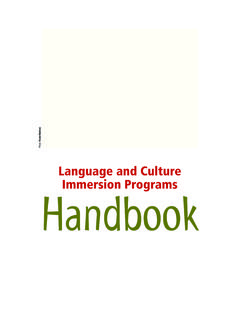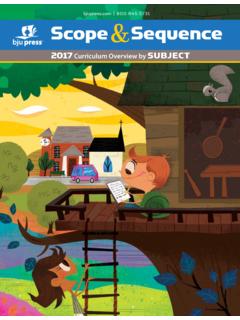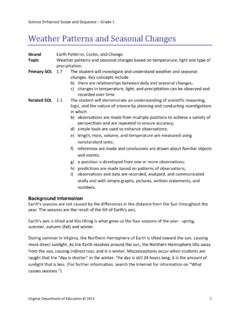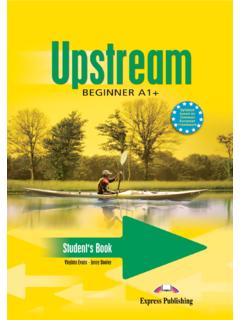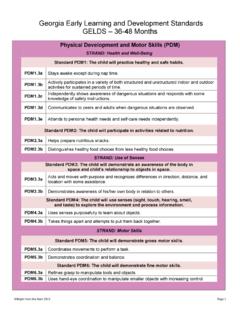Transcription of English Language Curriculum - Tampere
1 English Language Curriculum The Finnish International School of Tampere (FISTA) requires students to comply with the English Curriculum . This Curriculum includes goals, content and the criteria for evaluation. The specific meaning of these three is defined below. Goals: Students must have mutual respect for all cultures in the school. The learner must accept that there will be different learning strategies used in the classroom to ensure that all students achieve proficiency in the subjects taught. It is also essential that students learn to express themselves in the classroom. We also aim to develop the students' interest and pleasure in reading as well as developing their ability to write. The ultimate goal is that the student will have the opportunity to gain the fluency of English compatible to a native speaker at the end of the ninth grade. Content: It is important that the students have the ability to speak clearly and also have an understanding of what is being taught to them.
2 They must also be able to understand the vocabulary in the required texts and other assigned material by the teacher. Evaluation: For students to move forward in FISTA, they should demonstrate proficiency in English . Evaluation is crucial for the student to proceed in this school. The students must prove that they can understand routine discussions in English . Listening is an essential skill to demonstrate English competency. By the time the student completes the ninth grade, they should be able to give a factual and persuasive speech, presenting a topic or an argument sequencing points logically, defending views with evidence and making use of persuasive Language . In writing, the ultimate goal is to adapt style to genre and purpose and to use a variety of sources to plan writing, notes, texts, websites. In FISTA the students learn Language , but they also learn through Language . Language helps the student to clarify and interpret experiences, to acquire new concepts, and to add depth to concepts already grasped.
3 Oral Language is a crucial factor in the development of the student's cognitive abilities and it facilitates the acquisition of social and communicative skills. It is, above all, the principal integrating element in the English Curriculum . Activities such as comprehension, responding to text and the approach to writing are grounded in a process of talk and discussion. Technological skills are essential for advancement in education. The English Curriculum allows for opportunities to integrate information and communication technologies into the teaching and learning process and provides students with opportunities to use modern technology to enhance their learning in all other subjects as well. 1. In the English Curriculum the term 1st grade' refers to the year group in question. The phrases grade 5' and grade 8' represent the evaluation grade marked in the student's school report card. At the very end of the English Curriculum you will find a Glossary of Terms and appendixes.
4 The appendixes are supplementary attachments to the assessments / certificates. Appendix 1: Content-and- Language -Integrated-Learning (CLIL) English Assessment Student's Language Proficiency Appendix for Grade 6. Appendix 2: Content-and- Language -Integrated-Learning (CLIL) English Assessment Appendix to Basic Education Certificate for Grade 9. Appendix 3: Content-and- Language -Integrated-Learning (CLIL) English Assessment Transfer Certificate for Students Moving Abroad Appendix 4 includes guidelines for teachers to fill in the appendixes as supplementary attachments to assessments / certificates. 1st grade: Goals and Learning Strategies Speaking and listening: Students learn to speak and pronounce clearly, thinking about the needs of their listeners. They work in small groups, as a class and joining in discussions. They also learn how to listen carefully to what other people are saying, so that they can remember the main points. Reading: Students' interest and pleasure in reading is developed as they learn to read.
5 As well as focusing on words and sentences, they work out the meaning of straightforward texts. Visual aids enhance this strategy. Writing: Students learn the symbolic nature of writing, the sounds and names of letters and how to write them. They learn the basics of phonological patterns and spelling. They also learn to write familiar words and brief sentences. 2. Handwriting: The school handwriting policy aims to lead students to mastering a quick, legible and efficient style. Students are taught a Standard Print Style first, and then a Standard Cursive Style (handwriting according to the Finnish school system). Contents Developing phonic skills Letter formation and articulation Recognizing common words, rhyming words, word families Reading stories Expanding vocabulary Writing simple sentences and short pieces of text, spelling Listening to stories and engaging in group discussions Sharing own experiences and making predictions Language structure Phonemes Letter sounds (graphemes).
6 Short and long vowel, consonants Segmenting and blending Grapheme phoneme correspondences and phoneme grapheme correspondences The alphabet The ordinal numbers Simple Language structures, such as pronouns (he / she / it), a basic use of apostrophe (it is it's, he is he's). Simple adjectives, prepositions, basic conjunctions Silent e Literature Narrative Stories with familiar settings Traditional fairy tales Stories about fantasy worlds Non-narrative Instructions Lists Poetry Rhymes Evaluation 3. Proficiency level for skills below average (grade 5). Listening Comprehension: Can understand a limited number of words, short sentences, questions and requests of a personal or immediate nature. Struggles to understand even simple utterances without explicit contextual cues. Requires significant help: slower speech, repetition, pointing, and translation. Speaking Skills: Can answer simple questions about personal details in short sentences. Interaction relies on the conversational partner and the speaker may need to resort to his/her mother tongue or gestures.
7 Speech may contain frequent long pauses, repetitions and breakdowns. Pronunciation may cause major problems of understanding. Can use a very limited basic vocabulary and some standard memorized phrases. Cannot express himself/herself freely, but the few formulaic utterances that he/she can manage may be relatively free of mistakes. Reading Comprehension: Is familiar with the alphabet, but understands little of the text. Recognizes a small number of familiar words and short phrases and can tie these in with pictures. Has a very limited ability to understand an unfamiliar word even in very predictable contexts. Writing Skills: below Can only understand a few expressions when listening to others. Can only communicate using a few expressions. Can only write a few letters and common words. Can only express himself/herself using a limited vocabulary. Proficiency level for good skills (grade 8). Listening Comprehension: Can understand simple utterances (personal questions and everyday instructions, requests and warnings) in routine discussions with support from context.
8 Can follow simple discussions related to concrete situations or personal experience. 4. Can only understand simple messages if delivered in standard dialect, at a slower than normal rate and addressed to him/her personally. Speaking Skills: Can briefly describe himself/herself and his/her immediate surroundings (environment, family, situation, etc.). Can manage in the most straightforward dialogues and interactive situations. Sometimes requires help from the conversational partner. Can express himself/herself fluently in the most familiar sequences, but pauses and breaks are very evident in other parts of speech. Pronunciation may sometimes cause misunderstandings. Can use a limited number of short memorised expressions, the most essential vocabulary and basic sentence structure. Plenty of basic grammatical errors occur frequently even in elementary speech. Reading Comprehension: Can read familiar and some unfamiliar words. Can understand very short messages dealing with everyday life and routine events or giving simple instructions.
9 Can locate specific information required in a short text (postcards, weather forecasts). Reading and understanding of even brief passages of text is very slow and limited. Writing Skills: Can communicate immediate needs in brief sentences. Can write a few sentences and phrases about himself/herself and his/her immediate situation (such as answers to questions or notes). Can use some basic words and phrases and write very simple main clauses. Memorized phrases may be written accurately, but prone to a very wide variety of errors even in the most elementary free writing. **. 2nd grade: Goals and Learning Strategies Speaking and listening: Students learn to sustain concentration while listening and take turns in speaking. They learn to explain their own behaviour and views and take part in frequent group and class discussions. They also learn to develop questioning skills and make comparisons. 5. Reading: Students share and explain their reactions to texts commenting on important aspects and making imaginative links to their own experiences.
10 They recognize words with common spelling patterns and how word order affects meaning. Writing: Students spell the words in a recognizable way based on an awareness of the most common spelling strings and patterns. They learn to put words into alphabetical order and use dictionaries. Students write simple stories and narrative texts about feelings and experiences learning to use capital letters, full stops and question marks. Handwriting: By the end of the second year students learn to write in a Standard Cursive Style. Contents Plurals and pronouns Alphabetical order Dictionary work Writing simple stories and narrative texts Listening to stories and drawing and writing about it Reading different kinds of stories Basic spelling Language structure Demonstratives The present simple of be'. Can for ability Have got Prepositions of place Possessive adjectives The present simple The present simple of like Prepositions of time The conjunction and'. Comparative adjectives The past simple of be'.
